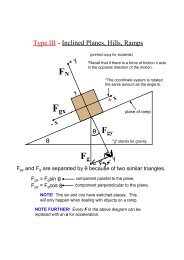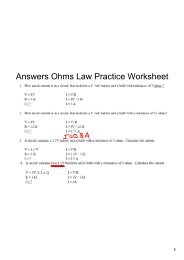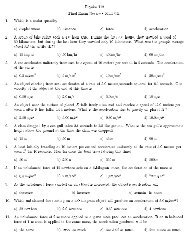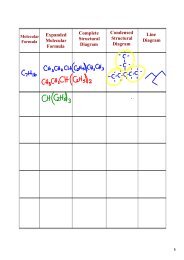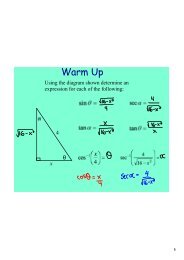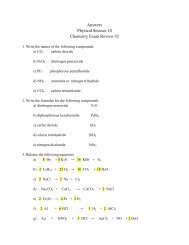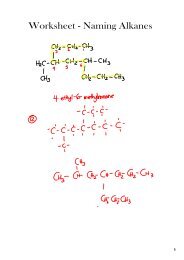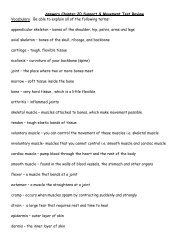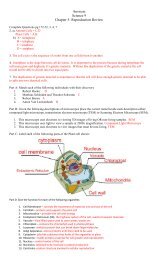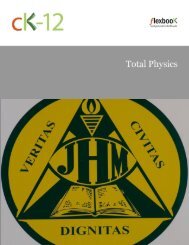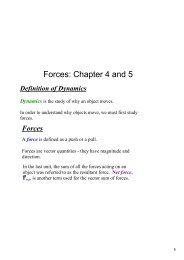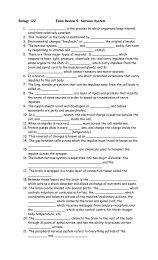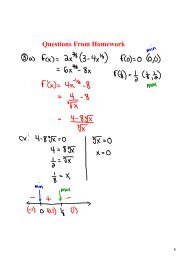Physics Study Guides.pdf - James M. Hill Memorial High School
Physics Study Guides.pdf - James M. Hill Memorial High School
Physics Study Guides.pdf - James M. Hill Memorial High School
Create successful ePaper yourself
Turn your PDF publications into a flip-book with our unique Google optimized e-Paper software.
ElectrostaticsBig Picture<strong>Study</strong> <strong>Guides</strong>All objects have positive and negative charges inside them. If the number of positive and negative charges are equal,as they most often are, then the object is neutral. Charged objects are objects with more positive charges thannegative ones, or vice versa. Opposite charges attract, and similar charges repel. Electric fields are created by a netcharge and point away from positive charges and towards negative charges. Many macroscopic forces can be attributedto the electrostatic forces between molecules and atoms.<strong>Physics</strong>Disclaimer:Key TermsCharge: Charge is carried by protons and electrons. Charge is always conserved in a closed system. SI unit: CCoulomb’s Law: Coulomb’s law states that the force between two charges is proportional to the value of the twocharges and inversely proportional to the square of the distance between them.Electric Field: Electric fields surround electrically charged particles and affect other electrically charged particles.The field itself is a vector force field - it indicates the direction a positive charge at a given point would move. Theelectric field can also be thought of as the force per unit charge at a given point, similar to a gravitational field. SIunits: N/C = V/mConductors: Materials where electricity can pass through easily, meaning that electrons can easily move inside thematerial.Insulators: Materials where electricity cannot pass through easily.Semiconductors: Materials with a conductivity between the conductivities of insulators and normal conductors.Superconductors: Materials with exactly zero resistance below certain temperatures.Plasma: A conductive state of matter, similar to gas, containing ions and/or free electrons.Voltage: Potential energy measured as a difference in potential between two points in space. SI units: VEquipotential Lines: Lines linking points of equal voltage around a point charge. Around point charges, equipotentiallines just form circles around the charge. In more complex arrangements, equipotential lines can make all sorts ofshapes. Equipotential surfaces are the same as equipotential lines, except in 3-dimensional space.Coulomb’s LawThere are two types of charge: positive and negative.• Electrons have negative charge.• Protons have positive charge.• The magnitude of the charge is the same for electrons and protons: e = 1.6 × 10 -19 CCoulomb’s law is used to calculate the force between two charged particles:, where k is a constant, q is the charge, and r is the distance between the charged particles.The force can be attractive or repulsive depending on the charges:• Like charges (charges with the same sign) repel• Charges with opposite signs attractElectric FieldElectric force can be represented by an electric field.The field E due to a single point charge q is: .The field describes the force a charged object will feel if it entersthe field. If another point charge q 0 is in the field, it will feel a forceF = Eq 0 .A simple diagram can tell us a lot about an electric field - the densityof the field lines in a region indicates the strength of the field,and parallel lines (like between two charged plates) mean that thefield is constant.Electric fields can interact with each other just like gravitationalfields. To determine the direction and magnitude of the electricfield at any point, just add the vectors from all of the differentelectric fields at that point. To the right is an illustration of theelectric field between a positive charge and a negative charge.The lines show the direction a positive charge placed in the fieldwill take. Image Credit: Sharayanan, CC-BY-SA 3.0This guide was created by Christopher Addiego and Catherine Wu. To learnmore about the student authors, visit http://www.ck12.org/about/about-us/team/interns.Page 1 of 4v1.1.10.2012this study guide was not created to replaceyour textbook and is for classroom or individual use only.




